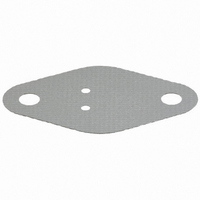SP400-0.009-00-11 Bergquist, SP400-0.009-00-11 Datasheet - Page 18

SP400-0.009-00-11
Manufacturer Part Number
SP400-0.009-00-11
Description
THERMAL PAD TO-3 .009" SP400
Manufacturer
Bergquist
Series
Sil-Pad® 400r
Specifications of SP400-0.009-00-11
Usage
TO-3, TO-66
Shape
Rhombus
Outline
33.32mm x 19.35mm
Thickness
0.009" (0.229mm)
Backing, Carrier
Fiberglass
Color
Gray
Thermal Resistivity
1.40°C/W
Thermal Conductivity
0.9 W/m-K
Lead Free Status / RoHS Status
Lead free / RoHS Compliant
Adhesive
-
Other names
7403-09FR-11
BER218
BER218
16
Electrical Design Considerations
t
t
t
Proof Test
The purpose of "Proof Testing" Thermal Clad substrates is to verify
that no defects reside in the dielectric material. Because testing
requires that voltages be above the onset of partial discharge, we rec-
ommend the number of “Proof Tests” be kept at a minimum.
The term "Partial Discharge" includes a broad spectrum of life
reducing (i.e. material damaging) phenomena such as:
1.
2.
3.
4.
“Proof Test” fixture to test multiple number of finished circuit boards at one time.
Proof Testing
Breakdown Voltage
Creepage Distance And Discharge
Corona discharge
Treeing and surface contamination
Surface discharges at interfaces, particularly during fault
induced voltage reversal
Internal discharges in voids or cavities within the dielectric
Breakdown Voltage
The ASTM definition of dielectric breakdown voltage is: the potential
difference at which dielectric failure occurs under prescribed condi-
tions in an electrical insulating material located between two elec-
trodes. This is permanent breakdown and is not recoverable. ASTM
goes on to state that the results obtained by this test can seldom be
used directly to determine the dielectric behavior of a material in an
actual application. This is not a test for “fit for use” in the application,
as is the “Proof Test” , which is used for detection of fabrication and
material defects to the dielectric insulation.
The purpose of the “Proof Test” is to verify that there has been no
degradation of the dielectric insulation due to the fabrication process
or any material defects. Continued testing at these voltage levels will
only take away from the life of the dielectric on the circuit board. It
has been repeatedly verified that “Proof Testing” above the inception
of partial discharge (700 Vac or 1200 Vac with proper use of solder-
mask) will detect any and all defects in the dielectric isolation in the
Thermal Clad circuit board. Any micro-fractures, delaminations or
micro-voids in the dielectric will breakdown or respond as a short
during the test.
The use of a DC “Proof Test” is recommended, from an operator
safety standpoint. The voltage levels typically used are 1500 to 2250
VDC. Due to the capacitive nature of the circuit board construction,
it is necessary to control the ramp up of the voltage to avoid nui-
sance tripping of the failure detect circuits in the tester and to main-
tain effective control of the test. This is to avoid premature surface
arcing or voltage overshoot. There is safety consideration when DC
testing, in that the operator must verify the board tested is fully dis-
charged, prior to removing from the test fixture. A more detailed dis-
cussion of “Proof Test” is available upon request.

























